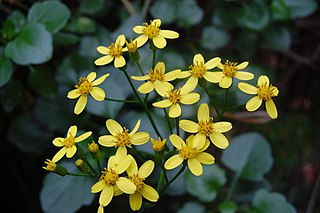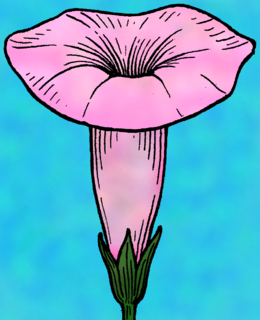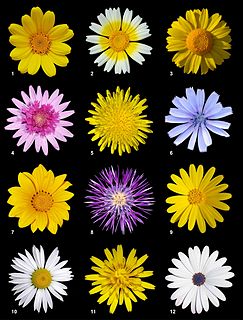
The Dioscoreales are an order of monocotyledonous flowering plants in modern classification systems, such as the Angiosperm Phylogeny Group and the Angiosperm Phylogeny Web. Within the monocots Dioscoreales are grouped in the lilioid monocots where they are in a sister group relationship with the Pandanales. Of necessity the Dioscoreales contain the family Dioscoreaceae which includes the yam (Dioscorea) that is used as an important food source in many regions around the globe. Older systems tended to place all lilioid monocots with reticulate veined leaves in Dioscoreales. As currently circumscribed by phylogenetic analysis using combined morphology and molecular methods, Dioscreales contains many reticulate veined vines in Dioscoraceae, it also includes the myco-heterotrophic Burmanniaceae and the autotrophic Nartheciaceae. The order consists of three families, 22 genera and about 850 species.

The flowering plants, also known as Angiospermae, or Magnoliophyta, are the most diverse group of land plants, with 64 orders, 416 families, approximately 13,000 known genera and 300,000 known species. Like gymnosperms, angiosperms are seed-producing plants. They are distinguished from gymnosperms by characteristics including flowers, endosperm within their seeds, and the production of fruits that contain the seeds. Etymologically, angiosperm means a plant that produces seeds within an enclosure; in other words, a fruiting plant. The term comes from the Greek words angeion and sperma (seed)

The dicotyledons, also known as dicots, are one of the two groups into which all the flowering plants or angiosperms were formerly divided. The name refers to one of the typical characteristics of the group, namely that the seed has two embryonic leaves or cotyledons. There are around 200,000 species within this group. The other group of flowering plants were called monocotyledons or monocots, typically having one cotyledon. Historically, these two groups formed the two divisions of the flowering plants.

Monocotyledons, commonly referred to as monocots, are grass and grass-like flowering plants (angiosperms), the seeds of which typically contain only one embryonic leaf, or cotyledon. They constitute one of the major groups into which the flowering plants have traditionally been divided, the rest of the flowering plants having two cotyledons and therefore classified as dicotyledons, or dicots.

The order Pinales in the division Pinophyta, class Pinopsida, comprises all the extant conifers. The distinguishing characteristic is the reproductive structure known as a cone produced by all Pinales. All of the extant conifers, such as cedar, celery-pine, cypress, fir, juniper, larch, pine, redwood, spruce, and yew, are included here. Some fossil conifers, however, belong to other distinct orders within the division Pinophyta.

Ranunculales is an order of flowering plants. Of necessity it contains the family Ranunculaceae, the buttercup family, because the name of the order is based on the name of a genus in that family. Ranunculales belongs to a paraphyletic group known as the basal eudicots. It is the most basal clade in this group; in other words, it is sister to the remaining eudicots. Widely known members include poppies, barberries, and buttercups.

Amborella is a monotypic genus of understory shrubs or small trees endemic to the main island, Grande Terre, of New Caledonia. The genus is the only member of the family Amborellaceae and the order Amborellales and contains a single species, Amborella trichopoda. Amborella is of great interest to plant systematists because molecular phylogenetic analyses consistently place it as the sister group to all other flowering plants.

Pandanales, the pandans or screw-pines, is an order of flowering plants placed in the monocot clade in the Angiosperm Phylogeny Group and Angiosperm Phylogeny Web systems. Within the monocots Pandanales are grouped in the lilioid monocots where they are in a sister group relationship with the Dioscoreales. Historically the order has consisted of a number of different families in different systems but modern classification of the order is based primarily on molecular phylogenetics despite diverse morphology which previously placed many of the families in other groupings based on apparent similarity. Members of the order have a subtropical distribution and includes trees, shrubs, and vines as well as herbaceous plants. The order consists of 5 families, 36 genera and about 1,610 species.

Austrobaileya is the sole genus consisting of a single species that constitutes the entire flowering plant family Austrobaileyaceae. The species Austrobaileya scandens grows naturally only in the Wet Tropics rainforests of northeastern Queensland, Australia.

Menispermaceae is a family of flowering plants. The alkaloid tubocurarine, a neuromuscular blocker and the active ingredient in the 'tube curare' form of the dart poison curare, is derived from the South American liana Chondrodendron tomentosum. Several other South American genera belonging to the family have been used to prepare the 'pot' and calabash' forms of curare. The family contains 68 genera with some 440 species, which are distributed throughout low-lying tropical areas with some species present in temperate and arid regions.

The eudicots, Eudicotidae or eudicotyledons are a clade of flowering plants mainly characterized by having two seed leaves upon germination. The term derives from Dicotyledons.

Trimeniaceae is a family of flowering plants recognized by most taxonomists, at least for the past several decades. It is a small family of one genus, Trimenia, with eight known species of woody plants, bearing essential oils. The family is subtropical to tropical and found in Southeast Asia, eastern Australia and on several Pacific Islands.
Plant taxonomy is the science that finds, identifies, describes, classifies, and names plants. It is one of the main branches of taxonomy.

(Sympetaly directs here)

A taxonomic system, the Bentham & Hooker system for seed plants, was published in Bentham and Hooker's Genera plantarum ad exemplaria imprimis in herbariis kewensibus servata definita in three volumes between 1862 and 1883.

Gamopetalae is an artificial historical group used in the identification of plants based on Bentham and Hooker's classification system.

Bicarpellatae is an artificial group used in the identification of plants based on Bentham and Hooker's classification system. George Bentham and Joseph Dalton Hooker published an excellent classification in three volumes in between 1862 and 1883. As a natural system of classification, it does not show evolutionary relationship between plants but still is a useful and popular system of classification based on a dichotomous key especially for the flowering plant groups (angiosperms). It is the most popular system of classification based on key characteristics enabling taxonomic students to quickly identify plant groups based only on physical characteristics. However, it is not a scientific group and is used for identification purposes only based on similar plant characteristics. Under the system Bicarpellatae are a group of plants based on an artificial and non scientific series. The group Bicarpellatea are Gamopetalae and dicotyledons. The group comprises;

Heteromerae is an artificial group used in the identification of plants based on Bentham and Hooker classification system. Bentham and Hooker published an excellent classification in three volumes between 1862 and 1883. As a natural system of classification, it does not show evolutionary relationship between plants but still is a useful and popular system of classification based on a dichotomous key. It is the most popular system of classification especially for the flowering plant groups (angiosperms) based on key characteristics. This enables taxonomic students to quickly identify plant groups based only on physical characteristics. Under the system Heteromerae is a Sub Class, Series ii and it is often not used. The series comprises;

Monochlamydae is an artificial taxonomic group used in the identification of plants. It was largely abandoned by taxonomists in the 19th century, but has been often used since. Bentham and Hooker's classification, published in 1880, used this grouping, but stated that it was neither natural nor well defined, and that De Candolle's system was superior. Under Engler and Prantl's revision of 1931, the group Monochlamydeae was completely abandoned.
The Ranales are an obsolete taxon of the Dicotyledons, with rank of order typified by Ranunculus (Ranunculaceae).


















